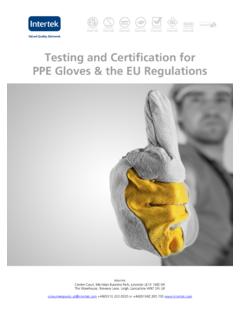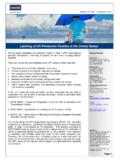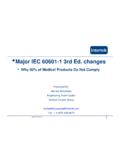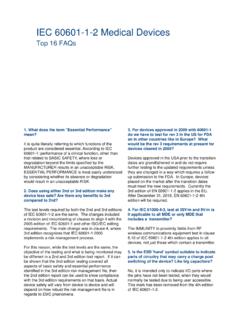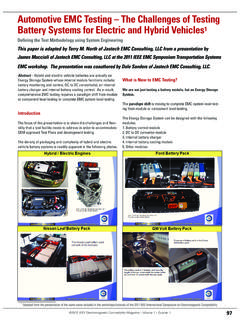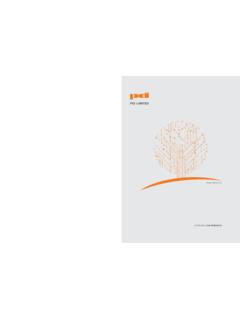Transcription of Effects of EMC on Smart Appliance Designs - Intertek
1 Effects of EMC on Smart Appliance Designs 1-800-WORLDLAB Effects of EMC. on Smart Appliance Designs Contents Introduction ..1. EMC - Electromagnetic compatibility ..1. Background ..3. EMC ..3. Emissions - USA ..5. Emissions - Japan ..6. Emissions - Designs for emissions Emissions and Susceptibility - EU ..8. Designs for disturbance power Harmonic and flicker emissions ..11. Designs for harmonic and flicker emissions Appliance susceptibility and EN 55014-2 ..12. Designs for susceptibility/immunity Powerline Radio ..16. Designs for communications compliance ..18. Product safety ..18. Functional safety ..19. Electromagnetic exposure ..19. EU low-frequency EMF limits: EN 50366 ..20. Designs for EMF RF exposure from Designs for RF exposure compliance.
2 23. 2. Effects of EMC. on Smart Appliance Designs Introduction When we hear the term Appliance we think of common household devices such as air conditioners, blenders, coffee makers, dishwashers, electric knives, fans, microwave ovens, refrigerators and vacuum cleaners. These examples contain among them motors, switches, thermostats and electrically-actuated valves all well-known electromechanical technologies, with perhaps some simple solid-state electronics added. Newer Appliance Designs are reducing cost, expanding functionality and increasing reliability by adopting programmable electronics such as application specific integrated circuits (ASICs), microprocessors, and intelligent sensors, transmitters and actuators. In addition, such Smart . appliances are adopting powerline and wireless communication techniques to enhance their utility even further for remote control over a Smart grid, or for remote recordkeeping, for example.
3 The migration of Appliance technology from electromechanical to programmable electronic and wireless has significant consequences for EMC design and regulatory compliance. Even for simple appliances , the designer may be faced with unfamiliar standards governing user safety and radio interference. For more complex appliances , stringent functional safety requirements may affect EMC testing. This document is intended to help the reader become aware of global EMC issues and design considerations for Smart appliances . It is not intended as a comprehensive catalog or toolkit. EMC consultants and test laboratories can provide targeted assistance with up-to-date information on regulations and compliance procedures. EMC - Electromagnetic compatibility Electromagnetic compatibility is defined as the condition which exists when equipment is performing its designed functions without causing or suffering unacceptable degradation due to electromagnetic interference to or from other equipment.
4 EMC refers to a kind of environmental equilibrium. In this case, the environment is an electromagnetic one - consisting of invisible disturbances which travel through the air or through metal cabinets or wires. 1. Effects of EMC. on Smart Appliance Designs EMC has two components, illustrated in the diagram below: 1) Electromagnetic emissions, from the Appliance itself; emissions from the Appliance can interfere with radio and TV broadcasting or sensitive services such as radio navigation or radio astronomy. The term EMI. (Electromagnetic Interference) refers to electromagnetic energy which interrupts, obstructs, or otherwise degrades or limits the effective performance of equipment; and 2) Electromagnetic susceptibility of the Appliance to disturbances in its environment, resulting in Appliance malfunctions caused by static discharges, radio transmitters, cell phones or other nearby electrical or electronic devices.
5 The term Immunity refers to the condition which exists when equipment operates within acceptable limits when exposed to electromagnetic environments imposed by an external source. When a particular Appliance is not generating excessive disturbances, and when it is operating correctly in the presence of such disturbances, the condition of electromagnetic compatibility is satisfied. Whether or not EMC is subject to government regulations in a particular market, EMC is an important design goal to assure reliable Appliance operation and to avoid interference to nearby devices and radio services. Over time, the nature of EMC considerations in the residential environment has changed. The introduction of digital circuitry into Appliance Designs has added narrowband, high frequency emissions to the possibility of broadband interference from DC motors and electromechanical switches.
6 Electromagnetic susceptibility has been affected both by the use of potentially sensitive semiconductors in appliances , and by a residential environment that now includes many more disturbance sources such as cell phones, portable phones, remote controls and home entertainment electronics. Electromagnetic Compatibility Electromagnetic emissions Electromagnetic susceptibility 2. Effects of EMC. on Smart Appliance Designs Regulatory requirements Background The regulation of electromagnetic emissions started with commercial radio broadcasting, so that interference with broadcast reception would be minimized. In the United States, the Federal Communications Commission (FCC) was established in 1934 to regulate broadcasting and interference. In the same year, the German High- frequency device law was published.
7 Spectrum regulators in other parts of the world were established around this same time to deal with the rapid growth of the broadcast industry. To this day, emissions are regulated worldwide to prevent interference to radio and TV broadcasting, and sensitive services such as radio navigation and radio astronomy. Immediately after radio receivers found their way into automobiles in the 1930's, the subject of susceptibility arose those receivers picked up interference from automotive ignitions and even static from the tires. Both sources of interference were quickly resolved, but the concept of EMC had been established. During the Second World War, the dense packaging and high power of military electronics accelerated the development of standards for both emissions and susceptibility.
8 Regulation of emissions from consumer devices grew mid-century with the advent of electrical household appliances and semiconductors, the latter enabling low-cost wireless remote controls and portable telephones. The digital electronics contained in personal computers that became popular during the 1970's was found to generate potent radio interference. As a result, digital device regulations were established around the world in the USA under FCC Part 15 Subpart J in 1979, internationally by the IEC standard CISPR 22 in 1985, and in the European Union under the EMC. Directive in 1989. EMC regulations now play an essential part in both governmental and private standards to prevent radio interference and assure equipment functionality in aerospace, automotive, commercial, medical, military and residential applications.
9 We will explore how Smart appliances pose unique EMC challenges for both design and regulatory compliance. EMC. The regulation of EMC varies around the world by product use and jurisdiction. In the United States of America (USA), only the emissions of residential and commercial appliances are specified adequate levels of susceptibility or immunity are left to the 3. Effects of EMC. on Smart Appliance Designs marketplace to determine. Emissions-only regulations for residential and commercial products are also found in Australia, Canada, China and Japan. Some common residential and commercial emissions standards are listed in Table 1 below: Product type USA European Union International Household appliances - EN 55014-1 CISPR 14-1. Audio/visual, broadcast receiver 47 CFR Part 15 EN 55013 CISPR 13.
10 Information technology (ITE) 47 CFR Part 15 EN 55022 CISPR 22. ISM (Industrial, Scientific, Medical). that generates radio-frequency 47 CFR Part 18 EN 55011 CISPR 11. energy Table 1 Common residential and commercial emissions standards In the European Union (EU), regulation of both emissions and immunity for residential, commercial and industrial products of all types is in force, to assure the free movement of goods among member states. South Korea has also adopted the more comprehensive approach of the EU. The most common residential and commercial susceptibility/immunity standards are listed in Table 2 below: Disturbance type Common source European Union International ESD (Electrostatic Static buildup EN 61000-4-2 IEC 61000-4-2. Discharge). Broadcast stations, Radio-frequency consumer wireless > 80 EN 61000-4-3 IEC 61000-4-3.


